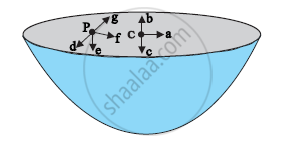Advertisements
Advertisements
Question
Multiple Choice Question. Select the correct option.
The mass of earth is 6 × 1024 kg and radius of earth is 6.4 × 106 m. The magnitude of force between the mass of 1 kg and the earth is:
Options
9.770 N
9.810 N
830 N
9.790 N
Solution
9.770 N
Explanation:
Mass of earth = m1 = 6 × 1024 kg
Mass of the body = m2 = 1 kg
Radius of earth = r = 6.4 × 106 m
Universal gravitational constant = G = 6.67 × 10−11 Nm2 kg−2
Force = F = ?
F = `("G m"_1 "m"_2)/"r"^2=(6.67xx10^-11xx6xx10^24xx1)/(6.4xx10^6)^2`
= `(6.67xx6xx10^(-11-12+24))/(6.4xx6.4)`
F = `(6.67xx6xx10)/(6.4xx6.4)`
F = 9.770 N
APPEARS IN
RELATED QUESTIONS
What happens to the force between two objects, if the mass of one object is doubled?
What happens to the force between two objects, if the distance between the objects is doubled and tripled?
The gravitational intensity at the centre of a hemispherical shell of uniform mass density has the direction indicated by the arrow (see Fig 8.12) (i) a, (ii) b, (iii) c, (iv) 0.

A thin spherical shell having uniform density is cut in two parts by a plane and kept separated as shown in the following figure. The point A is the centre of the plane section of the first part and B is the centre of the plane section of the second part. Show that the gravitational field at A due to the first part is equal in magnitude to the gravitational field at B due to the second part.

The law of gravitation gives the gravitational force between :
The acceleration produced by a force in an object is directly proportional to the applied _________ And inversely proportional to the _________ Of the object.
Why does a ball moving on a table top eventually stops?
Explain why:
The atmosphere does not escape.
Answer the following question.
What are the dimensions of the universal gravitational constant?
Three uniform spheres, each having mass m and radius r, are kept in such a way that each touches the other two. The magnitude of the gravitational force on any sphere due to the other two is
